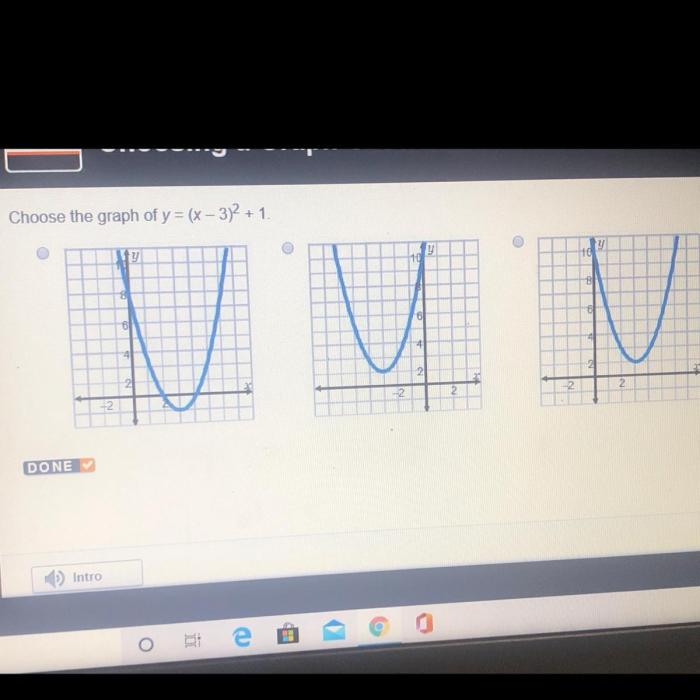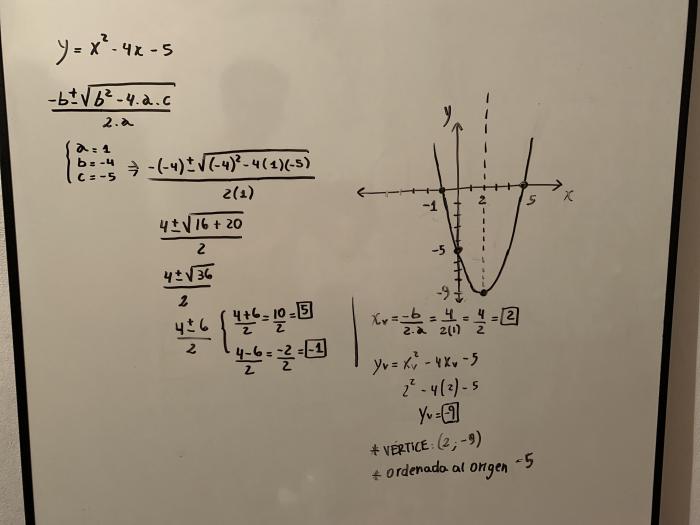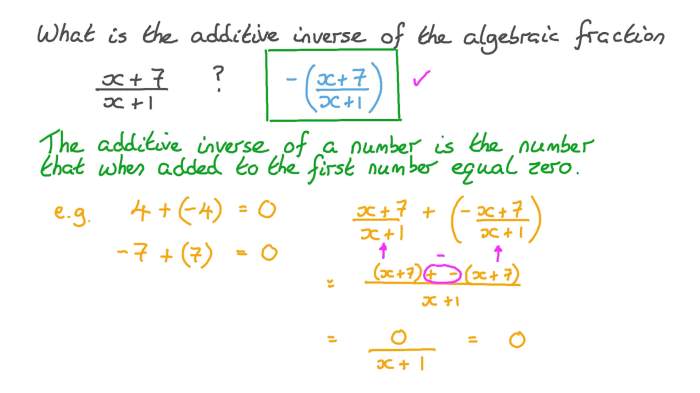Choose the graph of y x2 4x 5 – In the realm of mathematics, quadratic equations hold a special place, and among them, y = x² + 4x + 5 stands out as a prime example. This equation represents a parabola, a graceful curve that exhibits unique characteristics and finds applications in diverse fields.
Delving into the intricacies of this equation, we’ll explore its graphical representation, unravel its properties, and uncover its practical uses. Join us on this mathematical journey as we demystify the graph of y = x² + 4x + 5.
Quadratic Equation
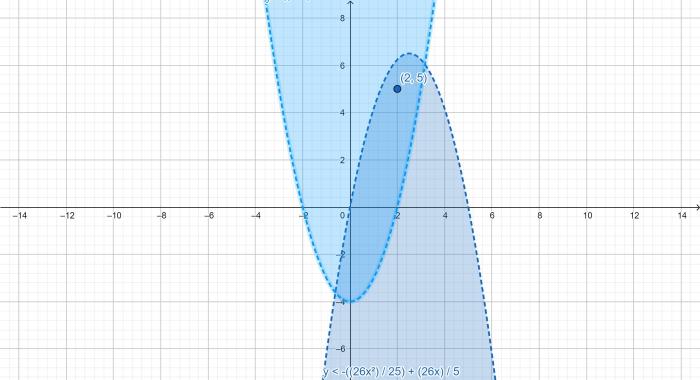
A quadratic equation is a mathematical equation in the form of y = ax^2 + bx + c, where a, b, and c are constants and x is the variable. The graph of a quadratic equation is a parabola, which is a U-shaped curve.
An example of a quadratic equation is y = x^2 + 4x + 5. This equation has a = 1, b = 4, and c = 5. The graph of this equation is a parabola that opens upward and has a vertex at (-2, 1).
Key Characteristics
The key characteristics of a quadratic equation include the vertex and the axis of symmetry.
Choosing the graph of y = x 2– 4x + 5 can be a breeze, especially if you brush up on your knowledge from Unit 8 Lesson 1: Joshua’s Law . With a firm grasp on the concepts covered there, you’ll have the tools to tackle this graph with confidence and precision.
- Vertex:The vertex of a parabola is the point where the parabola changes direction. The vertex of a quadratic equation in the form of y = ax^2 + bx + c is given by the formula x = -b/2a.
- Axis of symmetry:The axis of symmetry of a parabola is the vertical line that passes through the vertex. The axis of symmetry of a quadratic equation in the form of y = ax^2 + bx + c is given by the formula x = -b/2a.
Graphing a Quadratic Equation: Choose The Graph Of Y X2 4x 5
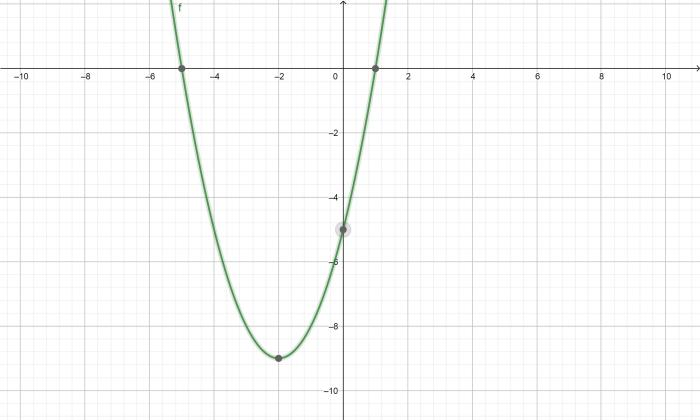
Graphing a quadratic equation is a crucial skill in algebra, allowing us to visualize the relationship between the variable and its square.
Steps Involved
- Put the equation in the standard form: y = ax² + bx + c
- Identify the coefficients a, b, and c.
- Find the vertex using the formula: x = -b/2a
- Calculate the y-coordinate of the vertex by substituting the x-value into the equation.
- Plot the vertex and additional points to create a smooth curve.
Finding the Vertex
The vertex of a parabola is the turning point, where the graph changes direction. To find the x-coordinate of the vertex, we use the formula:
x =
b/2a
Once we have the x-coordinate, we can find the y-coordinate by plugging it back into the original equation.
Plotting the Graph
With the vertex as a starting point, we can plot additional points by choosing different x-values and calculating the corresponding y-values. Connecting these points with a smooth curve gives us the graph of the quadratic equation.
Properties of the Graph
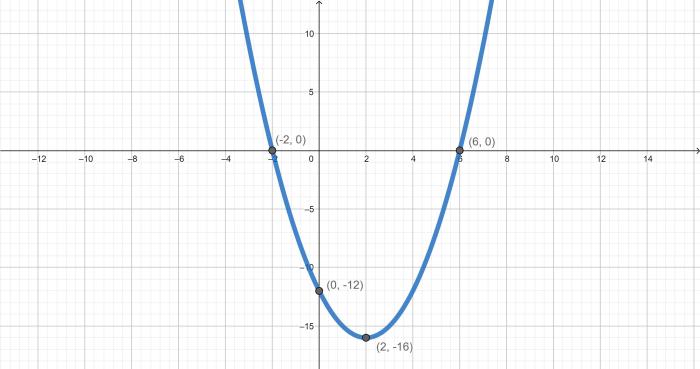
The graph of a quadratic equation is a parabola, a U-shaped curve. The shape of the parabola depends on the coefficients a, b, and c in the equation y = ax² + bx + c.
The Coefficients, Choose the graph of y x2 4x 5
- Coefficient a:Determines the overall shape and direction of the parabola.
- If a is positive, the parabola opens upward.
- If a is negative, the parabola opens downward.
- Coefficient b:Affects the horizontal position of the parabola.
- A positive value of b shifts the parabola to the left.
- A negative value of b shifts the parabola to the right.
- Coefficient c:Determines the vertical position of the parabola. It represents the y-intercept, where the parabola crosses the y-axis.
Intercepts
- Y-intercept:The point where the parabola crosses the y-axis. It is found by setting x = 0 in the equation y = ax² + bx + c.
- X-intercepts:The points where the parabola crosses the x-axis. They are found by setting y = 0 in the equation y = ax² + bx + c.
Applications of Quadratic Equations

Quadratic equations are powerful tools that can be used to model a wide variety of real-world phenomena. From the trajectory of a projectile to the shape of a parabola, quadratic equations can be used to describe and predict the behavior of many different systems.
Physics
In physics, quadratic equations are used to model a variety of phenomena, including projectile motion, the trajectory of a ball thrown into the air, the motion of a spring, and the shape of a lens.
For example, the equation \(y = -0.5gt^2 + vt + h\) can be used to model the trajectory of a projectile, where \(y\) is the height of the projectile, \(g\) is the acceleration due to gravity, \(v\) is the initial velocity of the projectile, \(t\) is the time, and \(h\) is the initial height of the projectile.
Engineering
In engineering, quadratic equations are used to model a variety of phenomena, including the strength of a beam, the efficiency of an engine, and the flow of water through a pipe.
For example, the equation \(y = kx^2 + bx + c\) can be used to model the strength of a beam, where \(y\) is the strength of the beam, \(x\) is the length of the beam, \(k\) is a constant that depends on the material of the beam, and \(b\) and \(c\) are constants that depend on the shape of the beam.
Other Fields
Quadratic equations are also used in a variety of other fields, including economics, biology, and chemistry.
For example, in economics, quadratic equations can be used to model the relationship between supply and demand, and in biology, quadratic equations can be used to model the growth of a population.
Limitations
While quadratic equations are a powerful tool, they do have some limitations.
One limitation is that quadratic equations can only be used to model systems that are parabolic in shape. This means that quadratic equations cannot be used to model systems that are linear, exponential, or any other shape.
Another limitation is that quadratic equations can only be used to model systems that are deterministic. This means that quadratic equations cannot be used to model systems that are random or chaotic.
Frequently Asked Questions
What is the vertex of the parabola represented by y = x² + 4x + 5?
The vertex of the parabola is (-2, 1).
How do I find the x-intercepts of the parabola?
To find the x-intercepts, set y = 0 and solve for x. The x-intercepts are (-5, 0) and (-1, 0).
Can quadratic equations be used to model real-world scenarios?
Yes, quadratic equations are widely used in fields such as physics, engineering, and economics to model phenomena like projectile motion, circuit analysis, and supply and demand.
